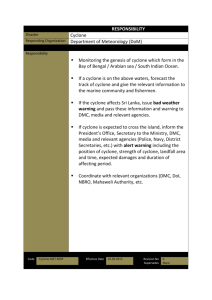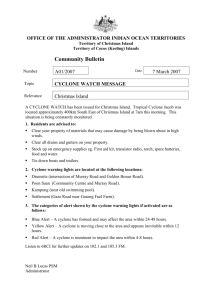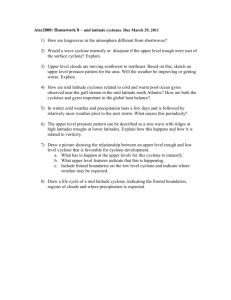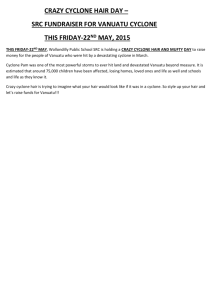THE DESIGN OF A WASTE HEAT SYSTEM CAPABLE OF
advertisement
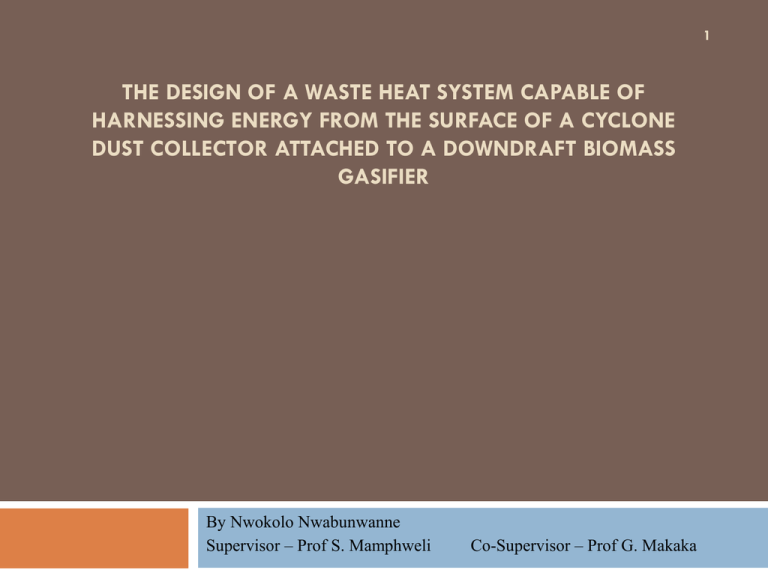
1 THE DESIGN OF A WASTE HEAT SYSTEM CAPABLE OF HARNESSING ENERGY FROM THE SURFACE OF A CYCLONE DUST COLLECTOR ATTACHED TO A DOWNDRAFT BIOMASS GASIFIER By Nwokolo Nwabunwanne Supervisor – Prof S. Mamphweli Co-Supervisor – Prof G. Makaka Introduction 2 Biomass Gasification- is the conversion of biomass material into a gaseous fuel known as snygas. Cn H xOy N z mO2 3.76 N 2 x1H 2 x2CO x3CO2 x4 H 2O x5CH 4 x6C ( z 2 3.76m) N 2 Where n, x, y and z are the atomic ratio of carbon, hydrogen, oxygen and nitrogen. x1, x2, x3, x4, x5, x6 and m are the stoichiometeric amount of the hydrogen, carbon monoxide, carbon dioxide, water, methane, carbon, nitrogen and air. Johansson Biomass Gasifier 3 Gasification Reactions 4 Table 1: Shows series of chemical reactions that occur during the conversion of biomass into useful products in a gasification system [Ruiz et al, 2013] Reaction type Oxidation reactions C + O2 → CO2 C + ½O2 → CO H2 + ½O2 → H2O CH4 + 2O2 ↔ CO2 + 2H2O Reduction reaction C + CO2 ↔ 2CO C + H2O ↔ CO + H2 C + 2H2 ↔ CH4 C + ½O2 → CO Shift reaction CO +H2O ↔ CO2 + H2 Methanization reaction 2CO + 2H2 → CH4 + CO2 CO + 3H2 ↔ CH4 + H2O CO2 + 4H2 → CH4 + 2H2O Steam reactions CH4 + H2O ↔ CO + 2H2 CH4 + ½O2 → CO + 2H2 Heat of reaction No -394 kJ/mol -284 kJ/mol -242 kJ/mol +803 kJ/mol R1 R2 R3 R4 +172 kJ/mol +131 kJ/mol +74.8 kJ/mol -111 kJ/mol R5 R6 R7 R8 +41.2 kJ/mol R9 -247 kJ/mol +206 kJ/mol -165 kJ/mol R10 R11 R12 +206 kJ/mol +36 kJ/mol R13 R14 Previous study on SJBG 5 Table 2: Optimum operating condition of the gasifier [Mamphweli and Meyer, 2009] Parameter Fuel/air ratio Pressure Temperature (Maximum) Value/Quantity 0.26 1 bar 1300°C Air Temperature Fuel Moisture content 25°C 10-12% Table 3: Average gas composition of the Gasifier [Johansson, 2002] Gases Composition (%) CO H2 CO2 CH4 N2 22.3-24.3 22.3-22.5 10.7-9.8 1.90-2.10 42.9-41.5 Table 4: Determined Efficiencies of the System [Nwokolo et al, 2014] Efficiency Type Cold gas efficiency Value (%) 88.11 Electrical power efficiency 23.2 Overall Efficiency 20.5 Problem Statement 6 There is a significant heat energy lost in gas scrubber. Gas temperature drops from between 450°C – 500°C to room temperature. Heat exchanger will thermal efficiency. improve Figure 2: Schematic flow diagram of a cyclone [Wang, 2004] Research Objectives 7 To quantify the amount of heat that could be recovered so as to ascertain the feasibility of heat recovery from the surface of the cyclone. To employ mathematical modeling for predicting the quantity of heat that could be effectively harnessed from the surface of the cyclone. To manufacture and monitor the performance of a cyclone heat exchanger capable of harnessing the heat from the hot syngas as well as removing fine carbon particles. To compare the results obtained through mathematical modeling to the measured results in order to validate the mathematical model developed. To employ the developed model in the optimization of heat recovery from the surface of the cyclone. To evaluate the impact of heat recovery at the cyclone on the overall thermal efficiency of the gasifier system. Significance of the Study 8 Combined heat and power (CHP) CHP Fuel Distribution Enhanced efficiency 15% 2% 3% oil 11% Efficient fuel Utilization Coal Wood 67% waste 2% other Natural gas Environmental benefits Diversification [Bluestein, 2004] Research Method 9 Infrared Camera Thermocouple Wires External Power supply Data Logger Figure 3: Temperature measurement setup Table 5: Main dimensions of the cyclone Item Dimensions (cm) Cyclone cylinder height 22 Cyclone cone height 101 Cyclone outside diameter 111 Cyclone inlet duct length 50 Vortex finder length 45 Figure 4: Cyclone Dimensions Q=V×ρ×Cp ×ΔT Equ 2 Temperature Result and Discussion 10 500 TSL TSU Tin 450 400 Temperature (C) 350 300 250 200 150 100 50 0 0 20 40 60 Time (min) 80 100 120 Figure 5: Gas inlet and cyclone surface temperature profile within the first 120mins Temperature Results 11 600 TSL TSU Tin %Diff 550 500 Temperature (C) 450 400 350 300 250 200 150 100 50 115 120 125 130 135 140 145 Time (min) 150 155 160 165 Figure 6: Gas inlet and cyclone surface temperature profile after the first 120mins 220 235.3°C 200 180 Upper/Cylindrical part 160 <50.0°C 220.2°C Lower/Conical part Temperature (C) 12 Thermal Image and Temperature Gradient 140 120 100 Lowest part 80 <50.0°C 60 40 Figure 7: Thermal image of the cyclone 0 10 20 30 40 50 60 Length (cm) 70 80 90 Figure 8: Temperature gradient along the length of the cyclone 100 Quantity of Heat Determination 13 Table 6: Parameters for estimation of heat quantity Item H2 N2 CH4 CO CO2 Total Molar mass (g/mol) 2.02 28.01 16.04 28.01 44.01 118.09 % Composition of gas 22.30 42.90 1.90 22.30 10.70 100.1 Mass (g) 2.01 53.65 1.36 27.89 21.02 105.93 Specific heat capacity(kJ/kg K) 14.32 1.04 2.22 1.02 0.84 19.44 Hence the total quantity of heat was determined using equation 2 and parameters presented in table 7 and were found to be 665893.07kcal. Table 7: Waste heat temperature classifications and some source examples [US DOE, 2008] Type Temperature range Example source High 1650ºC – 649°C Hydrogen plant, Fume incinerator Medium 650ºC – 230°C Gas turbine exhaust, Catalytic crackers Low 232ºC and lower Welding machines, Annealing Furnaces Future Work 14 Cyclone surface temperature will be measured at 25%, 50%, 75% and 100% electrical load using type-k thermocouples and thermal camera. Model development. Model Validation and Optimization. Design and manufacturing of the heat exchanger. Performance monitoring of the heat exchanger. Thermal efficiency evaluation. 15 Thank You

